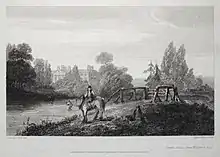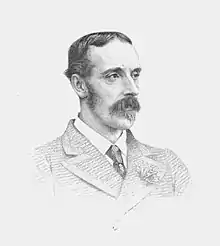Owen Williams (British Army officer)
Owen Lewis Cope Williams (13 July 1836 – 2 October 1904) was a British Army officer and Conservative politician who sat in the House of Commons from 1880 to 1885.[1] He belonged to the Marlborough House set around the future King Edward VII of the United Kingdom.[2]
Owen Williams | |
|---|---|
 Photograph of Williams, c. 1876 | |
| Member of Parliament for Great Marlow | |
| In office 1880–1885 | |
| Preceded by | Thomas Owen Wethered |
| Succeeded by | Constituency abolished |
| Personal details | |
| Born | Owen Lewis Cope Williams 13 July 1836 |
| Died | 2 October 1904 (aged 68) |
| Political party | Conservative |
| Spouse(s) |
Fanny Florence Caulfeild
(m. 1862; died 1876)Nina Mary Adelaide Sinclair |
| Relations | Hwfa Williams (brother) |
| Children | Owen Gwynedd St. George Williams |
| Parent(s) | Thomas Peers Williams Emily Bacon |
| Education | Eton College |
| Military service | |
| Branch/service | British Army |
| Years of service | 1854–1887 |
| Rank | Lieutenant General |
| Unit | Royal Horse Guards |
Early life
Williams was born into the landed gentry on 13 July 1836. He was the eldest son of Thomas Peers Williams, MP for Great Marlow, and the former Emily Bacon.[3] Among his siblings was Hwfa Williams, who became a courtier in the circle of the Prince of Wales, and his sisters, three of whom married into the nobility.[4]
His maternal grandfather was Anthony Bushby Bacon of Benham Park in Berkshire. Three generations of descent from Thomas Williams of Llanidan, who had made a fortune from the copper of Mynydd Parys.
He was educated at Eton College.[5]
Career
Williams joined the Royal Horse Guards in 1854. He became lieutenant in 1856, captain in 1858, major and lieutenant colonel in 1866.[5] He was colonel and commanding officer of the Royal Horse Guards from 1871 to 1882.[6] His successor was Frederick Burnaby, who had quarrelled with both Williams and the Prince of Wales as colonel-in-chief, and soon left the country. Williams became a major-general on half-pay in 1882 and retired as lieutenant general in 1887.[7]
At the 1880 general election Williams was elected MP for Great Marlow. He held the seat until 1885,[8] when it was abolished.
.jpg.webp)
Landowner
Upon his father's death in 1875, Williams became the owner of an extensive landed estate, in Wales and England.[9]

Williams was a J.P. for Buckinghamshire, Berkshire, Anglesey, Carnarvonshire and Flintshire.[10] He lived at Temple House at Bisham in Berkshire, not far from Marlow, Buckinghamshire. It had been built in 1790 for Thomas Williams of Llanidan, the architect being Samuel Wyatt.[11][12] It was adjacent to Temple Lock on the River Thames.[13]
In 1889 Williams sold the family Anglesey estate of 2,400 acres (970 ha) at Craig-y-Don.[14] That year he also sold the Marle estate, near Llandudno, Marle Hall going to Corbet Woodall.[15][16]
Personal life
Williams married, firstly, in 1862 Fanny Florence Caulfeild, daughter of St George Francis Caulfeild of Donamon Castle, Roscommon, who died in 1876.[17] He married, secondly, Nina Mary Adelaide Sinclair, daughter of Sir John Sinclair, 3rd Baronet.[1] She survived him and died in 1924, her heir being Hwfa Williams (died 1926), her husband's brother.[18][19][20] Temple House was demolished c.1922,[21] or c.1930.[11]

His son Owen Gwynedd St. George Williams (1865–1893) went to Mashonaland with Lord Randolph Churchill around 1891. He was killed as a scout on the Shangani Patrol during the Matabele War, on 26 October 1893.[22][23] A memorial to him was placed in Bisham Church.[24]
The Fast Set
Williams accompanied the Prince of Wales on his visit to India in 1875–6.[25] For the purposes of the royal suite for this journey, he had the title of equerry, with the courtiers Arthur Ellis and Dighton Probyn.[26] He also had a role of aide-de-camp, with Charles Beresford.[27] He was sent on a side trip from Bombay to Hyderabad state, in November 1875, in response to an invitation from its Prime Minister Salar Jung I, with Charles Harbord, 5th Baron Suffield and Francis Knollys.[28] William Howard Russell's entry for 3 February 1876, on a visit to an area 25 miles (40 km) from Agra known for wild boar, records that Williams had "got his hand in" at pig-sticking, as had Arthur Ellis and Augustus FitzGeorge.[29]
At the beginning of 1876 a potentially damaging scandal blew up, involving Williams's sister Edith, married to Heneage Finch, 7th Earl of Aylesford: who was in India with the Prince's party. She wrote to her husband in February of that year from Packington Hall, announcing her intention to run off with George Spencer-Churchill, Marquess of Blandford. George's brother Lord Randolph Churchill at the same time wrote to involve the Prince, whom he asked to moderate the reactions of Aylesford and Williams. Aylesford, however, sent a telegram to his mother, asking her to collect the children of the marriage; she had no idea of the circumstances, and Alexandra of Denmark, who knew what Edith intended, sent her husband the Prince a cipher telegram again asking him to smooth things over. Matters became embroiled since the Prince took Aylesford's side, while Randolph tried to pressure him over the existence of certain letters. Williams wrote to Charles Yorke, 5th Earl of Hardwicke, who was acting for the Prince in dealing with Randolph, suggesting Aylesford should challenge Blandford to a duel (by then illegal). Aylesford, by then returned from India, met Hardwicke in the House of Lords, and explained that instead he was divorcing Edith.[30]
In 1874 Sandown Park had come into Williams's possession, via his brother-in-law Lord Charles John Innes-Ker.[31] The racecourse there was managed by Hwfa Williams, his brother. In 1885, the founding with the backing of Leopold de Rothschild of the Eclipse Stakes, offering prize money of £10,000, saw the Williams brothers and their partner Wilford Brett make the reputation of the Sandown Park racecourse.[32][33] Sandown Park was one of a group of "gate-money" racecourses, within easy reach of London, that included also Hurst Park, Kempton Park and Lingfield Park, that towards the end of the 19th century broke the mould of louche venues with poor security. It was run at a good profit, and had subscribers.[34]
Williams was also a racehorse owner, using the trainer John Dawson.[35] He became a member of the Jockey Club in 1881.[36] He won the Portland Plate in 1887 with Lisbon.[37]
In 1877 Williams bought the yacht Enchantress from Joseph Florimond Loubat.[38][39] He was well known at Cowes Week regatta, and celebrated for the occasion when in a gale he told his skipper "We will not shorten sail", resulting in considerable damage.[40]
Williams was prominent in the Royal baccarat scandal of 1890–1, centred on allegations of cheating during two evening sessions at a private house party of the card game baccarat made against Sir William Gordon-Cumming.[41] In the subsequent slander case, it came out that Williams had acted as a croupier during the sessions.[42] His major role in the affair was, with Lord Coventry, to defend the reputation of the Prince of Wales by closing down the allegations, and to that end requiring Gordon-Cumming to pledge that he would not again play cards. As a cover-up, it failed.[41]
References
- "Williams, Lt-Gen. Owen Lewis Cope". Who's Who. A & C Black. Retrieved 21 March 2021. (Subscription or UK public library membership required.)
- Ridley, Jane. "Marlborough House set (act. 1870s–1901)". Oxford Dictionary of National Biography (online ed.). Oxford University Press. doi:10.1093/ref:odnb/53154. (Subscription or UK public library membership required.)
- Burke, Bernard (1882). A Genealogical and Heraldic History of the Landed Gentry of Great Britain & Ireland. Vol. II. Harrison. p. 1752.
- "Williams, Thomas (1737 - 1802), attorney, outstanding figure in the copper industry at the end of the 18th century | Dictionary of Welsh Biography". biography.wales.
- Dod's Parliamentary Companion. Dod's Parliamentary Companion, Limited. 1881. p. 327.
- Baily's Magazine of Sports and Pastimes. Vol. 42. Vinton. 1884. p. 265.
- Stearn, Roger T. "Burnaby, Frederick Gustavus". Oxford Dictionary of National Biography (online ed.). Oxford University Press. doi:10.1093/ref:odnb/4047. (Subscription or UK public library membership required.)
- Leigh Rayment's Historical List of MPs – Constituencies beginning with "G" (part 2)
- Bateman, John (1876). The Acre-ocracy of England: A List of All Owners of Three Thousand Acres and Upwards, with Their Possessions and Incomes, Arranged Under Their Various Counties, Also Their Colleges and Clubs. B.M. Pickering. p. 209.
- Debretts House of Commons and the Judicial Bench 1881
- Howard Colvin (1978). A Biographical Dictionary of British Architects 1600–1840. John Murray. p. 957. ISBN 0-7195-3328-7.
- Historic England. "Details from listed building database (1422375)". National Heritage List for England.
- Dickens, Charles (1880). Dickens's Dictionary of the Thames from Oxford to the Nore, 1880: An Unconventional Handbook. C. Dickens. p. 228.
- Truth. 1889. p. 96.
- "n/a". Oswestry Advertiser. 18 September 1889. p. 3.
- Bye-gones. Vol. I (2nd ser.). 1890. p. 228.
- Burke, Bernard (1894). A Genealogical and Heraldic History of the Landed Gentry of Great Britain & Ireland. Vol. I. Harrison. p. 307. ISBN 978-0-394-48726-7.
- "n/a". Truth. 20 February 1924. p. 9.
- Walford, Edward (c. 1920). The county families of the United Kingdom; or, Royal manual of the titled and untitled aristocracy of England, Wales, Scotland, and Ireland. Dalcassian Publishing Company. p. 1434.
- Seeley, Paul (2019). Richard D'Oyly Carte. Routledge. p. 154 note 3. ISBN 978-1-351-04589-6.
- "Temple House, England's Lost Country Houses". lostheritage.org.uk.
- Colvin, Ian (1922). Life of Jameson. Vol. I. London: Edward Arnold & Co. p. 278 note 2.
- Griffith, John Edwards (1914). Pedigrees of Anglesey and Carnarvonshire Families, with Their Collateral Branches in Denbighshire, Merionethshire, and Other Parts. Bridge Books. p. 409. ISBN 978-0-9508285-5-8.
- "Captain O G St G Williams". Imperial War Museums.
- Thom's Directory of Ireland. 1883. p. 472.
- Hibbert, Christopher (2007). Edward VII: The Last Victorian King. St. Martin's Publishing Group. p. 130. ISBN 978-0-230-61075-0.
- Lee, Sidney, ed. (1912). . Dictionary of National Biography (2nd supplement). Vol. 1. London: Smith, Elder & Co.
- Suffield, Charles Harbord; Lowth, Alys (1913). My Memories, 1830-1913. London : H. Jenkins limited. p. 160.
- Russell, William Howard (1877). The Prince of Wales' tour: a diary in India; with some account of the visits of His Royal Highness to the courts of Greece, Egypt, Spain, and Portugal. London S. Low, Marston, Searle & Rivington. p. 454.
- Aubyn, Giles St (1979). Edward VII: Prince and King. Collins. pp. 172–179. ISBN 978-0-00-216203-6.
- St. Stephen's Review. Vol. 2. 1889. p. 16.
- Bedford, Julian (1989). The World Atlas of Horse Racing. Mallard. p. 32. ISBN 978-0-7924-5018-4.
- Sports Ticket: Live the Action!. Aesculus Press Ltd. 2004. p. 237. ISBN 978-1-904328-24-7.
- Black & White. H.S. Wood. 1891. p. 493.
- Lee, Sidney, ed. (1912). . Dictionary of National Biography (2nd supplement). Vol. 1. London: Smith, Elder & Co.
- William, Ruff (1881). Guide to the Turf. p. 747.
- The Saturday Review of Politics, Literature, Science and Art. J. W. Parker and Son. 1887. p. 421.
- Loubat, Joseph Florimond (1887). A yachtsman's scrap book: or, The ups and downs of yacht racing. New York: Brentano Brothers. p. 258.
- Vincent, James Edmund; Griggs, Frederick Landseer Maur (1906). Highways and Byways in Berkshire;. London : Macmillan and Co., Limited; New York, The Macmillan Company. p. 305.
- Suffield, Charles Harbord; Lowth, Alys (1913). My Memories, 1830-1913. London : H. Jenkins limited. p. 285.
- Tomes, Jason. "Cumming, Sir William Gordon Gordon-, fourth baronet". Oxford Dictionary of National Biography (online ed.). Oxford University Press. doi:10.1093/ref:odnb/39392. (Subscription or UK public library membership required.)
- Clarke, Sir Edward George; Gordon-Cumming (bart.), Sir William Gordon (1891). Gordon-Cumming V. Wilson and Others: Speeches for the Plaintiff Delivered by Sir Edward Clarke. Stevens & Haynes. p. 24.